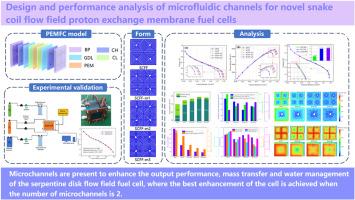新型蛇形线圈流场质子交换膜燃料电池微流控通道设计及性能分析
IF 8.3
2区 工程技术
Q1 CHEMISTRY, PHYSICAL
引用次数: 0
摘要
精细化流场设计是提高质子交换膜燃料电池(pemfc)性能的关键研究方向。本文建立了带有微通道结构的蛇形线圈流场(SCFF) PEMFC的数值模型,从多个角度研究了微通道结构对电池性能的影响。本文建立了三维多相非等温PEMFC模型,并基于实验数据验证了模型的准确性。其次,基于流道压降和净功率分析了电池输出性能。然后,通过考察反应物分布均匀性和浓度极化现象来评价流场传质能力。最后,结合质子电导率和液态水饱和度六个方面对电池的水管理能力进行了分析。结果表明,将微通道结构整合到电池设计中可以提高输出性能、传质能力和水管理能力。与无微通道的SCFF相比,当微通道数为2时,其流道压降降低了147.0%,净功率提高了8.37%,且电化学反应越激烈,水含量和液态水饱和度越低。此外,我们观察到微通道数量的持续增加并没有导致细胞性能的增强。本研究为利用PEMFC多物理场分析研究微通道流场对电池性能的影响提供了有价值的参考点。本文章由计算机程序翻译,如有差异,请以英文原文为准。

Design and performance analysis of microfluidic channels for novel snake coil flow field proton exchange membrane fuel cells
Developing refined flow field design is a pivotal research direction aimed at enhancing the performance of proton exchange membrane fuel cells (PEMFCs). In this paper, a numerical model of a snake coil flow field (SCFF) PEMFC with a microchannel structure is constructed to investigate the effect of the microchannel structure on cell performance from multiple perspectives. The construction of a 3D multi-phase non-isothermal PEMFC model is carried out in this paper, and the accuracy of the models is verified based on experimental data. Secondly, the cell output performance is analyzed based on the pressure drop in the flow channel as well as the net power. Subsequently, the flow field mass transfer capability is appraised by examining the uniformity of reactant distribution and the concentration polarization phenomenon. Finally, the H2O management capability of the cell is analyzed based on a combination of six aspects, including proton conductivity and liquid water saturation. The results demonstrate that the incorporation of microchannel structures into the design of the cell results in enhanced output performance, mass transfer capability, and H2O management. In comparison to the SCFF without microchannels, the flow channel pressure drop is reduced by 147.0 % when the number of microchannels is optimal at 2, the net power is increased by 8.37 %, and the more intense electrochemical reaction is accompanied by lower water content and liquid water saturation. Furthermore, it is observed that the continuous increase in the number of microchannels did not result in enhanced cell performance. This study is a valuable reference point for the investigation of microchannel flow field effects on cell performance using PEMFC multiphysics field analysis.
求助全文
通过发布文献求助,成功后即可免费获取论文全文。
去求助
来源期刊

International Journal of Hydrogen Energy
工程技术-环境科学
CiteScore
13.50
自引率
25.00%
发文量
3502
审稿时长
60 days
期刊介绍:
The objective of the International Journal of Hydrogen Energy is to facilitate the exchange of new ideas, technological advancements, and research findings in the field of Hydrogen Energy among scientists and engineers worldwide. This journal showcases original research, both analytical and experimental, covering various aspects of Hydrogen Energy. These include production, storage, transmission, utilization, enabling technologies, environmental impact, economic considerations, and global perspectives on hydrogen and its carriers such as NH3, CH4, alcohols, etc.
The utilization aspect encompasses various methods such as thermochemical (combustion), photochemical, electrochemical (fuel cells), and nuclear conversion of hydrogen, hydrogen isotopes, and hydrogen carriers into thermal, mechanical, and electrical energies. The applications of these energies can be found in transportation (including aerospace), industrial, commercial, and residential sectors.
 求助内容:
求助内容: 应助结果提醒方式:
应助结果提醒方式:


